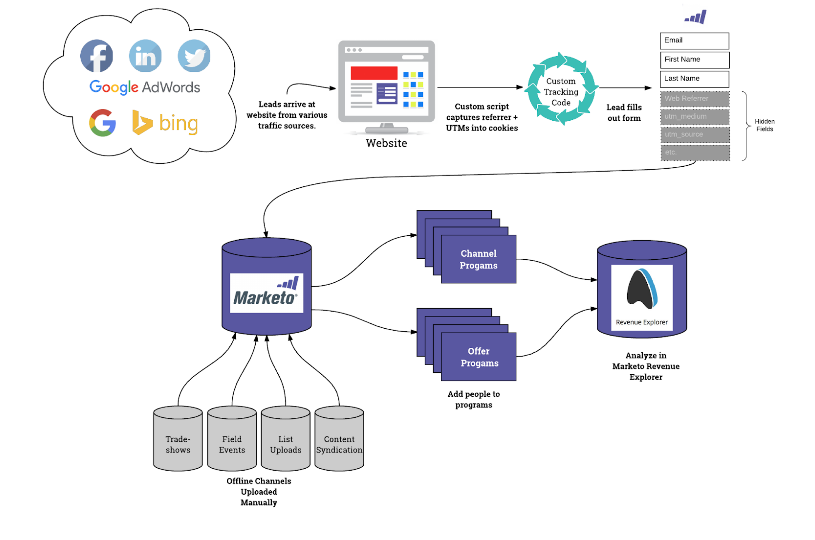If there’s one area marketers get hung up on more often than not, it’s reporting and attribution. From technology limitations to a lack of knowledge to an overwhelming amount of data, understanding contribution to revenue is (arguably) a marketer’s most challenging feat.
For those of you nodding your head, Marketo also understands your pain. In fact, that’s what prompted the acquisition of Bizible, a leading marketing analytics and performance management software. Bizible fills a major gap in Marketo’s functionality, delivering robust and easy-to-use marketing attribution capabilities—a welcome addition.
In our next post, we’ll cover the unique features of Bizible; in this post, let’s first define what exactly “attribution” is and how it works.
Understanding Marketing Attribution
Simply stated, marketing attribution is the process of determining which of your marketing efforts is driving revenue. As a byproduct, attribution tools also enable you to optimize marketing campaigns, resource allocations, and your marketing budget. How do they work?
Technology aside, all attribution systems essentially examine the intersection of three related datasets:
- Marketing Efforts: all the fantastic marketing campaigns you launched
- Audience Engagement: the people (prospects, customers, etc.) who engaged with your efforts
- Performance Outcomes: the results of your efforts. Usually, this is revenue or pipeline value but could also be a metric like MQLs.

When people engage with your marketing efforts then take the desired action, such as buying your product, we attribute some of that credit back to the marketing effort with which they interacted. The attribution methodology can be simple or tremendously complex, but all are based on this underlying theme.
Understanding Attribution Tools
In order for attribution tools to tie the three datasets together in a meaningful way, three primary functions must take place:
- Capture data
- Model data
- Visualize and report on data
To expand further...
Data Capture
Behind the scenes, your marketing attribution tool is tracking your efforts, engagement and outcomes. Marketing efforts and outcomes are fairly easy to keep an eye on since they are commonly recorded in your marketing automation and CRM systems. Engagement tracking, however, is another story and is where many marketing departments have gaps. The biggest challenge? Marketers need to worry about tracking both channels and offers. To clarify our terms:
Channels are the marketing tactics that drive engagement: paid search campaigns, SEO, paid and organic social, trade show booths—you get the idea.
Offers are what people engage with: ebooks, white papers, videos, web forms, webinars—and the list goes on.
Most companies do fairly well with tracking offers but stumble with tracking channels, and that’s not surprising. Tracking channels is significantly more difficult as it requires tagging your digital activities with UTM parameters, translating those parameters from website visits into cookies, and then incorporating that data into your marketing automation and CRM systems.
Even with Marketo, this process requires a fair amount of setup and skill and typically requires a skilled web developer. And unfortunately, many teams who try to track channels usually fall short—either the required configuration is not done effectively or it’s not done at all.
Data Modeling
OK—data captured…check. Now your attribution tool has to store your data in a way that allows for meaningful reporting. For marketing engagement, the simplest way to accomplish this is by adding fields to the person object in order to capture the data you want to report on—lead source is a prime example. The challenge, of course, is this is a “flat” data model, making it very difficult to capture and report on multiple interactions (and multiple dimensions of those interactions) with any sort of flexibility—the data model is simply too limited.
Let’s step our model up a notch—you could use another object to represent each of your marketing efforts and then connect people to that object when they engage with your marketing. This is what the Marketo program (or Salesforce campaign) represents: a person is connected to the marketing initiative via a junction object. (ex: campaign member status or Marketo program status) And while this model is quite flexible, it does have its limitations—but that’s a topic for another post.

Visualizing and Reporting on Data
Now we get to the fun part: the final step in the attribution process is to visualize and report on your results. This involves calculating credit for your performance outcomes (ex: opportunity revenue) vs. your marketing efforts and marketing engagement of the people involved in that opportunity.
There are many different methodologies for calculating attribution, often called “models.” A few of the more common models include “first touch” (all credit to the very first marketing engagement),” last touch” (all credit to the most recent marketing engagement), and “even split” (credit divided equally amongst all touches.) We’ll delve deeper into these and other types of models plus why you might choose one over another in a future post.
Closing Thoughts
We’ve all heard at some point in our careers: half of the money we spend on advertising is wasted, we just don’t know which half. Attribution tools can help you gain insight into your customer’s purchasing journey and optimize your marketing performance. After all, continual improvement is every marketer’s goal, isn’t it?
Does your organization need help achieving ROI from Marketo? Learn how the Marketo experts at MERGE can help. Contact us today!